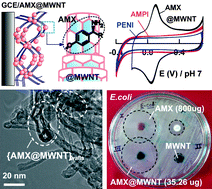Highly selective immobilization of amoxicillinantibiotic on carbon nanotube modified electrodes and its antibacterial activity†
Abstract
An electrochemical route for highly selective immobilization of a β-lactam family

* Corresponding authors
a
Environmental and Analytical Chemistry Division, School of Advanced Sciences, Vellore Institute of Technology University, Vellore, India
E-mail:
askumarchem@yahoo.com
Fax: +91 416 2243092
Tel: +91 -416- 2202754
b Division of Biomolecules and Genetics, School of Biosciences and Technology, Vellore Institute of Technology University, Vellore, India
c Department of Chemistry, National Chung Hsing University, Taichung, Taiwan
An electrochemical route for highly selective immobilization of a β-lactam family

 Please wait while we load your content...
Something went wrong. Try again?
Please wait while we load your content...
Something went wrong. Try again?
A. S. Kumar, S. Sornambikai, L. Deepika and J. Zen, J. Mater. Chem., 2010, 20, 10152 DOI: 10.1039/C0JM02262D
To request permission to reproduce material from this article, please go to the Copyright Clearance Center request page.
If you are an author contributing to an RSC publication, you do not need to request permission provided correct acknowledgement is given.
If you are the author of this article, you do not need to request permission to reproduce figures and diagrams provided correct acknowledgement is given. If you want to reproduce the whole article in a third-party publication (excluding your thesis/dissertation for which permission is not required) please go to the Copyright Clearance Center request page.
Read more about how to correctly acknowledge RSC content.
 Fetching data from CrossRef.
Fetching data from CrossRef.
This may take some time to load.
Loading related content
